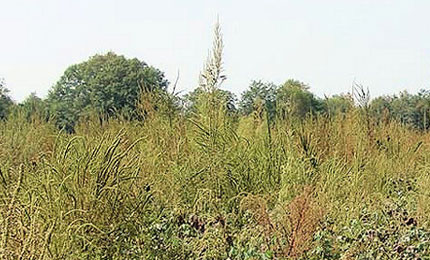Glyphosate resistant weeds are a major headache for US cotton growers. Using paraquat adds to the all-important diversity of mode of action necessary for successful weed control programs.
The US Cotton Belt stretches across 17 southern states, from Virginia and the Carolinas in the east to California, Arizona and New Mexico in the west.1
 Glyphosate resistant Palmer amaranth in cotton
Glyphosate resistant Palmer amaranth in cotton
Cotton varieties genetically modified to be tolerant to glyphosate were first planted in the US in 1997.2 This article looks at the impact that changes in weed control regimes have had and the advantages of using paraquat.3
Weed control in US cotton
Cotton is a poor competitor to weeds and is grown in climates where there are multiple flushes of new weed germination, especially when irrigated. Before the introduction of glyphosate tolerant varieties, weed control systems in cotton were complex, with pre-planting and inter-row tillage, and the use of herbicides with several modes of action.
Presented with an effective and easy option to control weeds post-emergence with glyphosate, many US growers chose to rely primarily on just this one herbicide in cotton, and in their corn and soybean crops too, as they opted to buy seed with glyphosate tolerance traits. Especially after the second generation of GM cotton varieties with improved tolerance to glyphosate (allowing latter application) were introduced in 2006, it became common for four or more applications of glyphosate to be made to a single crop.
The relentless advance of the use of a single mode of action has resulted in profound changes in the weed flora in US row crops. First, it was noticed how weeds less well controlled by lower rates of glyphosate became more prevalent. Then, only four years after glyphosate began to be used post-emergence in GM crops, the first population to have evolved resistance to the herbicide was recorded: horseweed (Conyza canadensis) in soybeans in Delaware.4
Glyphosate resistant weeds
Glyphosate resistant weed populations are now common throughout the Cotton Belt. Since the first population of glyphosate resistant horseweed in cotton was confirmed in Tennessee in 2001, eleven species are now officially listed as having resistant populations in US cotton (Table 1).
Table 1. Weed species with populations resistant to glyphosate in US cotton (International Survey of Herbicide Resistant Weeds).
|
Weed Species |
Common Name |
Year first resistance first recorded in US cotton |
|---|---|---|
|
Conyza canadensis |
Horseweed |
2001 |
|
Lolium multiflorum |
Italian ryegrass |
2005 |
|
Amaranthus palmeri |
Palmer amaranth |
2005 |
|
Ambrosia artemisifolia |
Common ragweed |
2006 |
|
Amaranthus tuberculatus |
Tall waterhemp |
2006 |
|
Kochia scoparia |
Kochia | 2007 |
|
Ambrosia trifida |
Giant ragweed |
2007 |
|
Echinochloa colona |
Jungle rice |
2008 |
|
Eleusine indica |
Goosegrass |
2010 |
|
Amaranthus spinosus |
Spiny amaranth |
2012 |
| Helianthus annuus | Common sunflower | 2015 |
Palmer amaranth (Amaranthus palmeri) is a weed species that has caused major problems in row crops across the Southern US. Populations in many US states have been reported to be resistant, not only to glyphosate, but also to other classes of herbicides including sulfonylureas, imidazolines (ALS inhibitors) and recently protoporphorinogen oxidase inhibitors (PPO inhibitors). Palmer amaranth is especially aggressive and invasive.5 Individual plants can grow to heights of over two metres and produce more than 100,000 tiny seeds. These are easily spread by rain run-off, farm equipment, birds and farm animals that have eaten cotton by-products.
Paraquat helps fight resistant weeds
The ramifications of glyphosate resistant weeds in cotton have been very serious. The University of Arkansas researchers noted in their paper3 that cotton farmers have had to completely revise their approach to weed control. New herbicide programs utilizing multiple effective modes of action form part of an integrated approach, which also includes planting varieties resistant to glufosinate as well as glyphosate, tillage and extensive hand weeding.
Paraquat controls important target weeds which are resistant to glyphosate. The GRAMOXONE® brand of paraquat herbicide is approved for use in US cotton pre-planting, pre-emergence or post-emergence as a directed spray between cotton rows using a shielded or hooded sprayer.
A key strategy to control Palmer amaranth is to deplete the seedbank in the soil. The seeds germinate readily and are not very persistent. New flushes are easily controlled by paraquat when weeds are less than 15 cm (six inches) tall. GRAMOXONE® is used from 2 -3 weeks before planting to at planting to clean-up weeds that may have emerged since an earlier burndown of winter and early summer annuals. It is also used in the fall to clear weeds emerging after harvest. Such late flushes of Palmer amaranth may even produce seed in the fall.
In order to improve control of particularly difficult weeds or to add residual control, paraquat can be mixed with other herbicides including S-metolachlor, prometryn, pendimethalin, norflurazon and some sulfonylureas.
References
- Cotton USA
- United States Department of Agriculture Economic Research Service
- Norsworthy, J K, Schwartz, L M and Barber L T (2016). The incidence and ramifications of glyphosate resistance in cotton. Pest Management Science, 27, (1), 31-35
- International Survey of Herbicide Resistant Weeds
- Legleiter, T and Johnson, W (2013). Palmer amaranth biology, identification and management. Purdue University Extension. WS-51
GRAMOXONE® is a Registered Trademark of a Syngenta Group Company.

